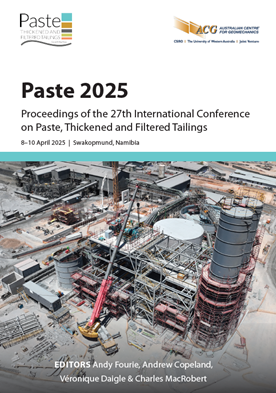Use of intensive remote monitoring and artificial intelligence to optimise paste pump availability on paste fill

|
Authors: Gamboa, U; Janzon, A |
DOI https://doi.org/10.36487/ACG_repo/2555_21
Cite As:
Gamboa, U & Janzon, A 2025, 'Use of intensive remote monitoring and artificial intelligence to optimise paste pump availability on paste fill', in AB Fourie, A Copeland, V Daigle & C MacRobert (eds), Paste 2025: Proceedings of the 27th International Conference on Paste, Thickened and Filtered Tailings, Australian Centre for Geomechanics, Perth, pp. 303-314, https://doi.org/10.36487/ACG_repo/2555_21
Abstract:
It is widely recognised that a conventional paste fill plant layout incorporates several pieces of equipment used to build and dispose of cemented paste in the underground mine. From all the related main equipment considered in a conventional paste plant, the pumping system plays a key and crucial role for paste pouring underground on a safe and controlled way through a high-quality paste that needs to meet the unconfined compressive strength (UCS) required underground based on the design to meet the mining cycle. This paper as a continuation of a previous paper presented by Gamboa & Castilla in 2024, aims to analyse and study how continuous monitoring of a piston-diaphragm type pump and the usage of artificial intelligence (AI) applied to the vast amount of data collected, has enabled the entire paste plant to achieve availabilities above 97% by substituting conventional preventive or corrective maintenance practices with a predictive procedure. Exploiting the data collected by the pumping system applied to paste fill will provide a good opportunity to create intelligent systems in the near future, as some works have been done already with a similar principle to predict UCS underground (Mariem et al. 2024). This system offers clear benefits on the pump and therefore paste plant availability and reliability, while enabling a smooth maintenance and paste production planning, with an optimum binder dosage and mining cycle synchronisation.
Keywords: paste pump, paste fill monitoring, artificial intelligence
References:
Correia, LDC & Jacobs, J 2024, ‘Effect of paste pump performance on the transient pressures and forces in an underground distribution system’, in AB Fourie & D Reid (eds), Paste 2024: Proceedings of the 26th International Conference on Paste, Thickened and Filtered Tailings, Australian Centre for Geomechanics, Perth, pp. 441–452,
Gamboa, U & Castilla, A 2024, ‘Availability of piston-diaphragm pump in paste fill: cement savings’, in AB Fourie & D Reid (eds), Paste 2024: Proceedings of the 26th International Conference on Paste, Thickened and Filtered Tailings, Australian Centre for Geomechanics, Perth, pp. 453–464,
Febritirtana, I, Kuswanto, D & Putra, D 2024, ‘Improvement in Big Gossan paste hybrid reticulation system design to optimise gravity flow: a case study’, in AB Fourie & D Reid (eds), Paste 2024: Proceedings of the 26th International Conference on Paste, Thickened and Filtered Tailings, Australian Centre for Geomechanics, Perth, pp. 495–504,
ACG_repo/2455_39
Mariem, A, Belem, T, Gélinas, LP, Mrad, H & Masmoudi, F 2024 ‘Driving advancements in the mining industry with intelligent solutions: developing a tool for predicting the Unconfined Compressive Strength of Cemented Paste Backfill’, Minefill 2024: Proceedings of the 14th International Symposium on Mining with Backfill, Vancouver.
© Copyright 2025, Australian Centre for Geomechanics (ACG), The University of Western Australia. All rights reserved.
View copyright/legal information
Please direct any queries or error reports to repository-acg@uwa.edu.au
View copyright/legal information
Please direct any queries or error reports to repository-acg@uwa.edu.au
